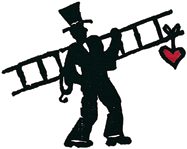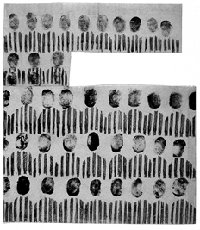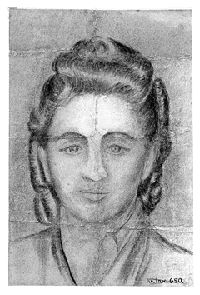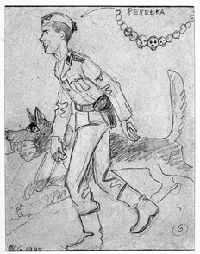 by Dena
Beard
by Dena
BeardThe Necessity of Human Representation
Block Museum at Northwestern University Exhibits Art from Auschwitz

The Last Expression: Art and Auschwitz, presented by
the Block Museum on Northwestern’s Evanston campus, is an exhibit of Auschwitz
prisoners’ art that veers past the usual sense of moral queasiness that
inevitably surrounds Holocaust memorials. Rather, the exhibit is successful
in its own right for showing us why art transcends an unfathomable experience.
Entering the exhibit, it becomes obvious that the Block Museum
did not intend to mildly approach this subject, as evidenced immediately by
the organization of the exhibition space. Like rats in a maze, the herded visitors
move between gray walls pierced curiously with narrow windows and recessed benches.
This none too subtle attempt to evoke the experience of Auschwitz certainly
hinders our right to a comprehensive view of the works on display, but maybe
the dramatic gesture is worth the price.
The first wall slams us with a quote from a commanding officer
at Auschwitz. The statement is an excerpt from a letter chastising fellow SS
officers for allowing artistic activities to proceed in the camp, stating that
art-making is reason enough for the severe punishment of a prisoner. Following
this are two paintings that explain the categories of art produced at the concentration
camp.
The first is a painting of female nudes in the classical
tradition, evidently commissioned by an SS officer. The second is a crude rendering called “A Friendly Favor,” which
depicts prisoners carrying a severely emaciated man. What we later learn from
this elementary demonstration is that the same Auschwitz commander that condemned
artistic activity at the camp eventually sanctioned commissioned works of art
from detainees as gifts for visiting officials, even establishing a
museum of Auschwitz art directly beneath the camp brothel. Of course, the sanctioned
paintings were severely restricted in style and content, and a drawing like
that depicting the starving inmate, had it been discovered, would have most
certainly meant death for the artist.
The second is a crude rendering called “A Friendly Favor,” which
depicts prisoners carrying a severely emaciated man. What we later learn from
this elementary demonstration is that the same Auschwitz commander that condemned
artistic activity at the camp eventually sanctioned commissioned works of art
from detainees as gifts for visiting officials, even establishing a
museum of Auschwitz art directly beneath the camp brothel. Of course, the sanctioned
paintings were severely restricted in style and content, and a drawing like
that depicting the starving inmate, had it been discovered, would have most
certainly meant death for the artist.
One of the inmates commissioned for paintings is quoted as
saying that the museum “saved lives,” in that it allowed detainees
to hold on to a certain degree of humanity. Ironically, most of those working
at the museum were one by one found to be making clandestine works with museum
materials, and for that reason almost all were put to death. The remaining prisoner
artwork ranges from kitschy flower paintings to haunting abstractions. The charcoal
blots of Jósef Szajna are like a countdown on a prison wall; he used
his fingerprint repeatedly to document the loss of individuality among the inmates
through time.
Resistance has been broken down into genre, and portraiture,
humor, and illustration have become subversions of the real conditions in the
camps. A computer towards the front holds the pages of Zofia Rozensztrauch’s
sketchbook, a haunting document so detailed in its images of prison life that
it became a key piece  of
evidence during the post-war trials. The caricature of an SS officer by Wicentry
Gawron is a mimic of a commissioned portrait Gawron was to do of the officer
with his dog; only in the caricature the officer himself has the gait and mannerisms
of the dog.
of
evidence during the post-war trials. The caricature of an SS officer by Wicentry
Gawron is a mimic of a commissioned portrait Gawron was to do of the officer
with his dog; only in the caricature the officer himself has the gait and mannerisms
of the dog.
A portrait of Mala Zimetbaum by Zofia Stepien´-Bator
[sic] holds the creases and folds of its history; Zimetbaum was found attempting
to escape from the camp and was eventually put
to death. As reverence for her courage and as an important representation of
defiance, her portrait passed hands until it was eventually smuggled out of
Aushwitz.
Suddenly we begin to grasp the fervor demonstrated in each
mark put on paper. We have unfastened ourselves from the grip of dejection now
and can see in each stroke of pencil an individual soliloquy.
This is not to say that those in Auschwitz made beautiful
art because of their situation, but the works point past all our knowledge of
the artistic practice and simply scrawl, in whatever base visual language, the
absolute necessity of human representation.